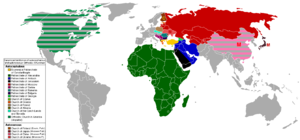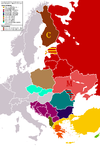How To Register Property As A Church
The Orthodox Church is the one Church building founded past Jesus Christ and his apostles, begun at the day of Pentecost with the descent of the Holy Spirit in A.D. 33. Information technology is also known (especially in the contemporary Westward) as the Eastern Orthodox Church or the Greek Orthodox Church. It may as well exist called the Orthodox Catholic Church building, the Orthodox Christian Church building, the one, holy, cosmic, and apostolic Church building, the Body of Christ, the Bride of Christ, or simply the Church.
The bishops of the Orthodox Churches trace unbroken succession to the very apostles themselves, therefore ultimately receiving their consecrations from our Lord Jesus Christ. All the bishops of the Eastern Orthodox Churches, no matter their titles, are equal in their sacramental part. The diverse titles given to bishops are only administrative or honorific in their essence. At an ecumenical council, each bishop may cast only one vote, whether he is the Ecumenical Patriarch or simply an auxiliary bishop without a diocese. Thus, there is no equivalent to the Roman Catholic papacy within the Eastern Orthodox Churches.
Equally with its Apostolic succession, the faith held by the Church building is that which was handed by Christ to the apostles. Nada is added to or subtracted from that eolith of organized religion which was "handed one time for all to the saints" (Jude 3). Throughout history, various heresies take afflicted the Church building, and at those times the Church makes dogmatic pronouncements (specially at ecumenical councils) delineating in new linguistic communication what has always been believed past the Church, thus preventing the spread of heresy and calling to repentance those who rend disconnected the Body of Christ. Its main argument of faith is the Nicene-Constantinopolitan Creed.
Contents
- 1 Very brief history
- 2 Beliefs and Practices
- 3 Current Church construction
- four Number of Adherents
- 5 References
- six See also
- vii Further reading
- seven.ane Published works
- seven.two External links
Very brief history
- More information: Timeline of Church History
Almost two thousand years ago, Jesus Christ, the Son of God, came to earth and founded the Church, through His Apostles and disciples, for the salvation of human. In the years which followed, the Apostles spread the Church and its teachings and founded many churches, all united in religion, worship, and the partaking of the Mysteries (or equally they are called in the W, the Sacraments) of the Holy Church building. The churches founded by the Apostles themselves include the Patriarchates of Alexandria, Antioch, Jerusalem, and Rome and Constantinople. The Church of Alexandria was founded by St. Mark, the Church of Antioch past St Paul, the Church building of Jerusalem by Ss. Peter and James, the Church of Rome by Ss. Peter and Paul, and Church building of Constantinople by St Andrew. Those founded in after years through the missionary activity of the first churches were the Churches of Sinai, Russia, Greece, Serbia, Bulgaria, Romania, and many others.
Each church has always had independent assistants, only, with the exception of the Church of Rome, which finally separated from the others in the year 1054, are united in faith, doctrine, Apostolic tradition, sacraments, liturgies, and services. Together they constitute what is called the "Orthodox Church", literally meaning "right didactics" or "right worship", derived from 2 Greek words: orthos, "right," and doxa, "teaching" or "worship."
The Orthodox Church historically stands in direct continuity with the earliest Christian communities founded in regions of the Eastern Mediterranean by the apostles of the Lord Jesus.
The destiny of Christianity in those areas was shaped by the transfer in A.D. 320 of the imperial capital from (Erstwhile) Rome to (New "Rome") Constantinople by Constantine I. As a consequence, during the commencement Eight Centuries of Church history, most major cultural, intellectual, and social developments in the Christian church also took place in that region; for instance, all ecumenical councils of that period met either in, or near Constantinople.
Missionaries, coming from Constantinople, converted the Slavs and other peoples of Eastern Europe to Christianity (Bulgaria, 864; Russia, 988) and translated Scripture and liturgical texts into the vernacular languages used in the various regions. Thus, the liturgy, traditions, and practices of the church of Constantinople were adopted past all and still provide the basic patterns of contemporary Orthodoxy.
Developments were not always consistent with the development of Western Christianity, where the bishop of Rome, or pope, came to be considered the successor of the campaigner Peter and head of the universal church building by divine appointment. Eastern Christians were willing to have the pope just as first among patriarchs. This deviation explains the various incidents that grew into a serious estrangement. 1 of the most vehement disputes concerned the filioque clause of the Nicene Creed, which the Western church added unilaterally to the original text.
The schism came slowly. The first major alienation came in the 9th century when the Pope refused to recognize the ballot of Photius as patriarch of Constantinople. Photius in turn challenged the right of the papacy to rule on the affair and denounced the filioque clause as a Western innovation.
The growing disputes between East and West reached some other peak in A.D. 1054, when common anathemas were exchanged. The sacking of Constantinople past the Fourth Cause (A.D. 1204) intensified Eastern hostility toward the Westward.
Attempts at reconciliation at the councils of Lyon (1274) and Florence (1438-39) were unsuccessful. When the papacy divers itself as infallible (First Vatican Council, A.D. 1870), the gulf between East and Westward grew wider. Only since the 2nd Vatican Council (1962-65) has the move reversed, talks are bringing serious attempts at mutual understanding.
Beliefs and Practices
- More data: Introduction to Orthodox Christianity
The Orthodox Church recognizes every bit authoritative the decisions of the 7 ecumenical councils that met between A.D. 325 and A.D. 787 and divers the basic doctrines on the Trinity and the Incarnation. In later centuries Orthodox councils also made doctrinal definitions on Grace (1341, 1351) and took a stand in reference to Western teachings.
The Church keeps the early traditions of Christianity, infants receive the Eucharist and confirmation, and the episcopate and the priesthood are understood in the light of Apostolic succession. (Apostolic Succession is understood to exist the passing on of the Holy Tradition past right-believing Bishops). Both married men and monks may become priests, but priests, bishops, and monks may not ally. The veneration of Mary, as Theotokos (Mother of God) is central to Orthodox Incarnational Theology, and the intercession of saints is also emphasized in the Orthodox Holy Tradition.
Later an early controversy on the subject, the Icons, of Christ, the Virgin Mary, and the saints are at present seen equally visible witnesses to the fact that God has taken human being flesh in the person of the Lord Jesus Christ.
The Liturgy used past the Orthodox Church has been translated from Greek into many languages. It is always sung, not but spoken. The true-blue receive Holy Communion on a spoon. They are given both the consecrated staff of life (NIKA), and the sanctified wine from the gifts offered and sanctified at the given Divine Liturgy. Holy Communion is never taken from any "reserve."
Monasticism, which had its origins in the Christian East (Egypt, Syria, Cappadocia), has since been considered in the Orthodox Church building every bit a prophetic ministry building of men and women, showing through their fashion of life the action of the Holy Spirit. The monastic democracy of Mountain ATHOS, Greece, is all the same viewed amid Orthodox Christians as a center of spiritual vitality.
Current Church structure

Map of the canonical territories of autocephalous and autonomous Orthodox jurisdictions. Click image to magnify.

More detailed European section of the above. Click image to magnify.
- More data: List of autocephalous and autonomous Churches
The Eastern Orthodox Churches of today consist of a family of fourteen autocephalous churches and 5 autonomous churches, sometimes referred to as jurisdictions. The number of autocephalous churches has varied in history. Autocephalous churches are fully self-governing in all they practise, while autonomous churches must take their primates confirmed by one of the autocephalous churches, unremarkably its female parent church building. All the Orthodox churches remain in full communion with ane another, sharing the same faith and praxis. There have been occasional breaks in communion due to diverse problems throughout history, but they generally remain brief and not developing into full schism. Information technology is hoped that the Great Schism, with the Church building of Rome, will anytime exist mended too.
The Patriarchate of Constantinople is also the Ecumenical Patriarchate and has the condition of "first among equals" amongst the Eastern Orthodox Churches. The Church is not a centralized system headed by a pontiff, but an organic customs guided past the Holy Spirit in the world. The unity of the Church building is visible in, and held together with, common organized religion and communion in the sacraments. No one but Christ himself is the real caput of the Orthodox Church.
Number of Adherents
The most mutual gauge of the number of Orthodox Christians worldwide is approximately 225-300 1000000 individuals.[1].
Other estimates, such as in The Encyclopedia of the Developing World,[2] place the number of overall Orthodox worshippers in 1996 at 182 1000000 individuals, including the post-obit breakup:
- Russian Federation: 70-80 million
- Ukraine: close to 30 million
- Romania: 20 million
- Greece: 9.5 million
- U.s.a.: close to 7 million
- Serbia and Montenegro: close to seven million
- Bulgaria: 6 million
- Belarus: five million
- Republic of kazakhstan: iv million
- Moldavia: three meg
- Georgia: 2.eight million
- FYROM: 1.2 million
- Uzbekistan: 900,000
- Poland: 800,000
- Germany: 550,000
- Australia: 480,000
- United Kingdom: 440,000
- Latvia: 400,000
- Estonia: 300,000
- France: 260,000
- Republic of lithuania: 150,000
- Austria: about seventy,000
- Switzerland: most lxx,000
- Republic of finland: 56,000
References
- ↑ Eastern Orthodox Church: Number of Adherents at Wikipedia.
- ↑ Thomas M. Leonard. Encyclopedia of the Developing World: Vol 3, O-Z Index. Taylor & Francis, 2006.
Come across also
- Ecclesiology
- Introduction to Orthodox Christianity
- Missiology
- Missionary
Further reading
Published works
The following are published writings that provide an introduction or overview of the Orthodox Church and its teachings:
From an Orthodox perspective
- Alfeyev, Hilarion; Rose, Jessica, ed. The Mystery of Faith: An Introduction to the Instruction and Spirituality of the Orthodox Church. (ISBN 0232524726)
- Bajis, Jordan. Common Ground: An Introduction to Eastern Christianity for the American Christian. (ISBN 0937032816)
- Bulgakov, Sergius. The Orthodox Church building. (ISBN 0881410519)
- Cunningham, Mary. Faith in the Byzantine World (IVP Histories Serial). (ISBN 0830823522)
- Chryssavgis, John. Low-cal Through Darkness: The Orthodox Tradition (Traditions of Christian Spirituality Series). (ISBN 1570755485)
- Coniaris, Anthony M. Introducing the Orthodox Church: Its Religion and Life. (ISBN 0937032255)
- Constantelos, Demetrios J. Agreement the Greek Orthodox Church. (ISBN 0917653505)
- Florovsky, George. Bible, Church, Tradition: An Eastern Orthodox View. (ISBN 0913124028)
- Ware, Timothy. The Orthodox Church. (ISBN 0140146563)
From a Heterodox perspective
- Binns, John. An Introduction to the Christian Orthodox Churches. (ISBN 0521667380)
- Fairbairn, Donald. Eastern Orthodoxy Through Western Eyes. (ISBN 0664224970)
- Fortescue, Adrian. The Orthodox Eastern Church building. (ISBN 0971598614)
- Roberson, Ronald. The Eastern Christian Churches: A Brief Survey. (ISBN 8872103215) - (also available online)
- Parry, Ken, ed.; Melling, David J., ed.; Brady, Dimitri, ed.; Griffith, Sidney Harrison, ed.; Healey, John F., ed. The Blackwell Dictionary of Eastern Christianity. (ISBN 0631232036)
External links
Overviews of the Orthodox Church
- Orthodoxy: The Narrow Path
Byzantine Studies
- A Basic Bibliography for Byzantine Studies
Source: https://orthodoxwiki.org/Orthodox_Church
Posted by: dickenaticeyound.blogspot.com


0 Response to "How To Register Property As A Church"
Post a Comment